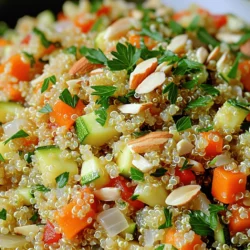Are you ready to enjoy a dish that’s both flavorful and good for you? Quinoa Vegetable Pilaf is a simple, tasty meal packed with nutrients. In this blog, I’ll guide you through the key ingredients, quick cooking steps, and helpful tips to make this dish a hit. Whether you’re a busy parent or a health-conscious foodie, this pilaf will fit right into your kitchen routine. Let’s dive in!
Ingredients
Key Ingredients for Quinoa Vegetable Pilaf
To make this dish, you need some essential ingredients. Here’s what you need:
– 1 cup quinoa, rinsed
– 2 cups vegetable broth
– 1 medium onion, finely chopped
– 2 carrots, diced
– 1 red bell pepper, diced
– 1 zucchini, diced
– 2 cloves garlic, minced
– 1 teaspoon cumin powder
– 1 teaspoon paprika
– Salt and pepper to taste
– 2 tablespoons olive oil
– 1/4 cup fresh parsley, chopped (for garnish)
These ingredients create a base full of flavor. Quinoa brings a nice texture, while the veggies add color and nutrition.
Optional Ingredients for Added Flavor
You can enhance your quinoa vegetable pilaf with additional flavors. Here are some optional ingredients:
– 1/4 cup slivered almonds
– Lemon zest or juice
– Fresh herbs like basil or cilantro
– A pinch of red pepper flakes
Adding slivered almonds gives a nice crunch. A splash of lemon adds brightness to the dish. Fresh herbs can make it even more vibrant.
Substitutions and Variations
You can easily change ingredients to suit your taste. Here are some ideas:
– Swap quinoa for couscous or brown rice.
– Use any vegetable broth or stock you prefer.
– Add different veggies like peas or spinach.
– Use garlic powder instead of fresh garlic.
These substitutions keep the dish fresh and exciting. You can adjust it based on what you have on hand or your dietary needs.
Step-by-Step Instructions
Preparation Steps
To start, gather your ingredients. You will need:
– 1 cup quinoa, rinsed
– 2 cups vegetable broth
– 1 medium onion, finely chopped
– 2 carrots, diced
– 1 red bell pepper, diced
– 1 zucchini, diced
– 2 cloves garlic, minced
– 1 teaspoon cumin powder
– 1 teaspoon paprika
– Salt and pepper to taste
– 2 tablespoons olive oil
– 1/4 cup fresh parsley, chopped (for garnish)
– 1/4 cup slivered almonds (optional)
Make sure to rinse the quinoa. This helps remove the bitter coating. Chop all your veggies and have them ready. It makes cooking easier and faster.
Cooking Instructions for Quinoa Vegetable Pilaf
1. Heat the olive oil in a medium saucepan over medium heat.
2. Add the chopped onion. Sauté until it turns clear, about 3-4 minutes.
3. Next, add the minced garlic, cumin, and paprika. Cook for 1 minute until you smell the spices.
4. Stir in the diced carrots, bell pepper, and zucchini. Cook for about 5-7 minutes until they start to soften.
5. Add the rinsed quinoa to the pan. Mix well with the veggies.
6. Pour in the vegetable broth and bring it to a simmer. Cover the pan and lower the heat.
7. Cook for about 15-20 minutes. The quinoa should absorb all the liquid.
8. After cooking, take the pan off the heat. Let it sit for 5 minutes.
9. Fluff the quinoa with a fork and season with salt and pepper.
10. If you like, add slivered almonds for a nice crunch.
11. Serve warm, and top with fresh parsley for a pop of color.
Tips for Perfecting Cooking Technique
– Always rinse your quinoa before cooking. This step makes a big difference in taste.
– Keep an eye on the heat. If it cooks too fast, it may burn.
– Let the quinoa sit after cooking. This helps it become fluffy and light.
– Experiment with spices. Add your favorite herbs to change the flavor.
Following these steps will help you make a delicious Quinoa Vegetable Pilaf.
Tips & Tricks
Enhancing Flavor with Seasonings
To boost the taste of your quinoa vegetable pilaf, use fresh herbs. Fresh parsley adds brightness. You can also try basil or cilantro for a different twist. Add a squeeze of lemon juice before serving. This gives a nice zing. Adjust salt and pepper to your liking. For extra depth, sprinkle a bit of cayenne pepper. It adds warmth without overwhelming the dish.
Serving Suggestions
Serve your pilaf warm in a bowl. You can top it with a drizzle of olive oil. This adds richness and flavor. Consider adding a dollop of yogurt on top for creaminess. It balances the dish well. Pair it with a crisp salad. A side of roasted vegetables makes a great addition too.
Pairings and Complementary Dishes
Quinoa vegetable pilaf pairs well with grilled chicken or fish. The lightness of the pilaf complements these proteins. For a vegetarian option, serve it with black bean tacos. The flavors mix nicely. You can also try it alongside a spicy curry. The mild quinoa helps tone down the heat.

Variations
Protein Additions
You can add protein to your quinoa vegetable pilaf to make it heartier. Some great options include:
– Chickpeas: These add a nice texture and flavor. Use one can, drained and rinsed.
– Tofu: Cut firm tofu into cubes and sauté it with the vegetables.
– Chicken: Cook diced chicken breast with the onions for added flavor and protein.
Each option boosts nutrition and makes the dish more filling. Feel free to mix and match based on what you have.
Gluten-Free and Vegan Options
Quinoa is naturally gluten-free, so this dish is a great choice for gluten-free diets. To ensure it remains vegan:
– Broth: Always use vegetable broth instead of chicken broth.
– No dairy: Skip any cheese or cream-based toppings.
This way, you keep the meal light and plant-based while still being super tasty.
Seasonal Vegetable Swaps
You can easily change the veggies based on the season. Here are some ideas:
– Spring: Try peas, asparagus, or artichokes for a fresh taste.
– Summer: Add corn, tomatoes, or eggplant for a vibrant dish.
– Fall: Use butternut squash, pumpkin, or Brussels sprouts for warmth.
– Winter: Root vegetables like parsnips or sweet potatoes add a nice touch.
These swaps keep the dish exciting and full of flavor all year long.
Storage Info
Best Practices for Storing Quinoa Vegetable Pilaf
To keep your quinoa vegetable pilaf fresh, store it in an airtight container. Let it cool to room temperature before sealing it. This helps prevent moisture buildup, which can lead to spoilage. You can store it in the fridge for up to five days. If you know you won’t eat it all, divide it into smaller portions. This makes it easy to grab a quick meal.
Reheating Tips
When it’s time to enjoy leftovers, reheat the pilaf gently. You can use the microwave or a stovetop. For the microwave, place the pilaf in a bowl and add a splash of water. Cover it with a lid or a damp paper towel. Heat for one to two minutes, stirring halfway through. On the stovetop, warm it in a pan over low heat, adding a bit of broth to keep it moist. Stir frequently until it’s heated through.
Freezing Instructions
Freezing quinoa vegetable pilaf is a great way to save it for later. First, let the pilaf cool completely. Then, transfer it to a freezer-safe container or bag. Remove as much air as possible to prevent freezer burn. You can freeze it for up to three months. When you’re ready to eat, thaw it in the fridge overnight. Reheat it as mentioned above for the best taste.
FAQs
How do I cook quinoa properly?
To cook quinoa, first rinse it under cold water. This removes any bitterness. Use a 2:1 ratio of liquid to quinoa. In a pot, combine quinoa and vegetable broth. Bring it to a boil, then reduce heat. Cover the pot and let it simmer for about 15 minutes. Once the liquid is absorbed, let it sit for five minutes. Fluff it with a fork before serving. This method ensures your quinoa is light and fluffy.
Can I use water instead of vegetable broth?
Yes, you can use water instead of vegetable broth. While broth adds flavor, water works well too. If you choose water, consider adding a pinch of salt. You can also add herbs or spices to boost the flavor. This way, your quinoa vegetable pilaf stays tasty and nutritious.
What vegetables can I add to Quinoa Vegetable Pilaf?
You can add many vegetables to quinoa vegetable pilaf. Some great options include:
– Peas
– Spinach
– Broccoli
– Corn
– Mushrooms
Feel free to mix and match based on your taste or what you have on hand. Fresh or frozen vegetables both work well. The key is to cut them into small pieces for even cooking.
How long does Quinoa Vegetable Pilaf last in the fridge?
Quinoa vegetable pilaf lasts about 4 to 5 days in the fridge. Store it in an airtight container to keep it fresh. When you’re ready to eat, simply reheat it in the microwave or on the stove. If it seems dry, add a splash of water or broth while reheating. Enjoy the flavors again!
Quinoa vegetable pilaf is a tasty and flexible dish. We explored key ingredients and optional flavors to enhance your meal. I shared step-by-step cooking tips to ensure your pilaf turns out perfectly every time. Don’t forget about variations to keep things exciting, with ways to make it vegan or add protein. For storage, I provided the best methods to keep leftovers fresh. With these insights, you can enjoy this healthy dish in many ways. Experiment and make it your own!


